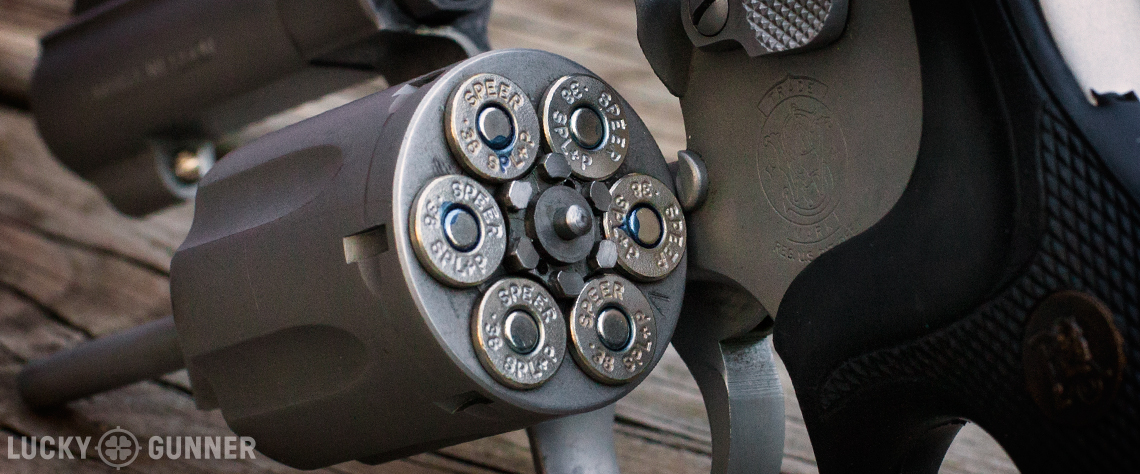Being a fan of the fighting revolver in 2015 is often a frustrating experience. There’s a big disconnect between the revolvers we want and the revolvers we can have. Some complain about the demise of the .41 magnum, the criminally high prices of used Colt Pythons, or the fact that .327 magnum never gained any traction. But for me, the problem is a decided lack of viable options for real mid-size carry revolvers.
But there are a few out there, and as our Wheel Gun Wednesday regulars know, I’ve spent some time this year putting these mid-size revolvers through their paces. Today’s video has the details:
What is “Mid-Size” Anyway?
A key component of my frustration is the fact that “mid-size” is a relative term. Typically, any revolver bigger than a S&W J-Frame Airweight but smaller than a steel N-Frame .44 magnum is considered to be in the medium size range. And I suppose that’s technically correct, but I think of mid-size more in relation to how we label modern auto pistols.
A compact or “mid-size” semi-auto weighs around 20-30 ounces and has a 3-4 inch barrel. Since pistol barrel measurements include the chamber and revolver barrels do not, that’s the equivalent of a 20-30 ounce revolver with a 2-3 inch barrel. Most revolvers fitting that description are not mid-size — they’re small, but heavy. They’re more like a Ruger LCP that weighs as much as a fully loaded Glock 19 but is still just as hard to shoot as a standard LCP.
But I’m stubborn, and unwilling to accept that a revolver can be easy to shoot or easy to carry, but can’t be both. So I embarked on the Quest for the Ideal Carry Revolver™. I started with the S&W 386, a lightweight L-Frame snubby, and then moved to the classic 3-inch K-frame models 66 and 64. Then I tried out the Ruger SP101, followed finally by the J-frame S&W 640 Pro and 60 Pro.
If you’ve been following along with us at home, then you know I eventually chose the Model 66, and made some modifications to create what I call The Best Revolver In the World™. And the video above summarizes my overall impressions of the five runners-up (or is it runner-ups?).
The Honorable Mentions
There are several revolvers that almost met the criteria I set up for this project, but I skipped over them for one reason or another.
Smith & Wesson Model 12 – The S&W 12 is a lightweight aluminum K-Frame revolver that was discontinued back in the 80s. Most had 2-inch or 4-inch barrels. Model 12s are plentiful on the used market, and relatively affordable. At 19 ounces unloaded, it would probably meet the weight requirement with a new set of stocks. The only other criteria where it falls short is the sights. Shooting the Model 64 confirmed that I still have a tough time with the small post and groove style S&W fixed sights, and I knew the Model 12’s would be no better. That said, if I ever seriously decided to carry a revolver as a primary on a daily basis, the Model 12 would get a second look for those days when the 66 feels too heavy, but I still want six shots and a K-frame trigger.
Smith & Wesson Model 315 – This was part of the S&W “Nightguard” line from a few years ago. It’s essentially an updated Model 12 with a 2.5 inch barrel, much better sights, and rated for +P ammo. I’d pick up one in a heartbeat but S&W made very few (rumored to be well under 1000) and on the rare occasion a used one shows up for sale online, they’re usually well over $1K.
Ruger GP-100 – I’ve owned a GP100 before and I really like them, but they are just too chunky for me to carry. If I had tried one for the carry revolver project, it would have been the Wiley Clapp model — 3-inch barrel with Novak sights (similar to the SP101 in the video).
Ruger Security Six – I also once had an old “Six” series revolver (Security Six, Service Six, Speed Six), and while it was a great shooter for what I paid for it at the time, the triggers are not great, and aren’t easily improved. There’s also not much aftermarket support for them.
Colt Revolvers – I admit I’m not super familiar with Colt’s now-discontinued line of double action revolvers, but I think the Detective Special could have been a nice contender for my project. Unfortunately, with a finite supply on the used market, prices are high and aftermarket support is not great. There’s lots of “stuff” out there for Colt revolvers, but most of it seems to be fancy leather holsters and stocks geared more toward making the Colts look like traditional show pieces. In terms of modern offerings for grips, holsters, sights, and speed loaders, there’s not much to choose from.
Budget Brands – I don’t want to name any names, lest I offend someone’s delicate sensibilities, but anytime I do a list like this, there are always questions about the low-end budget brands that I’ll call “Morris” and “Tartar Farms”. These companies have, at times, introduced some pretty interesting products, but the execution leaves much to be desired. Maybe one day they’ll put out a product that I’d be willing to trust my life to, but based on what I’ve seen to date, you’re really rolling the dice when you put down money for a wheel gun that was made on the cheap.



